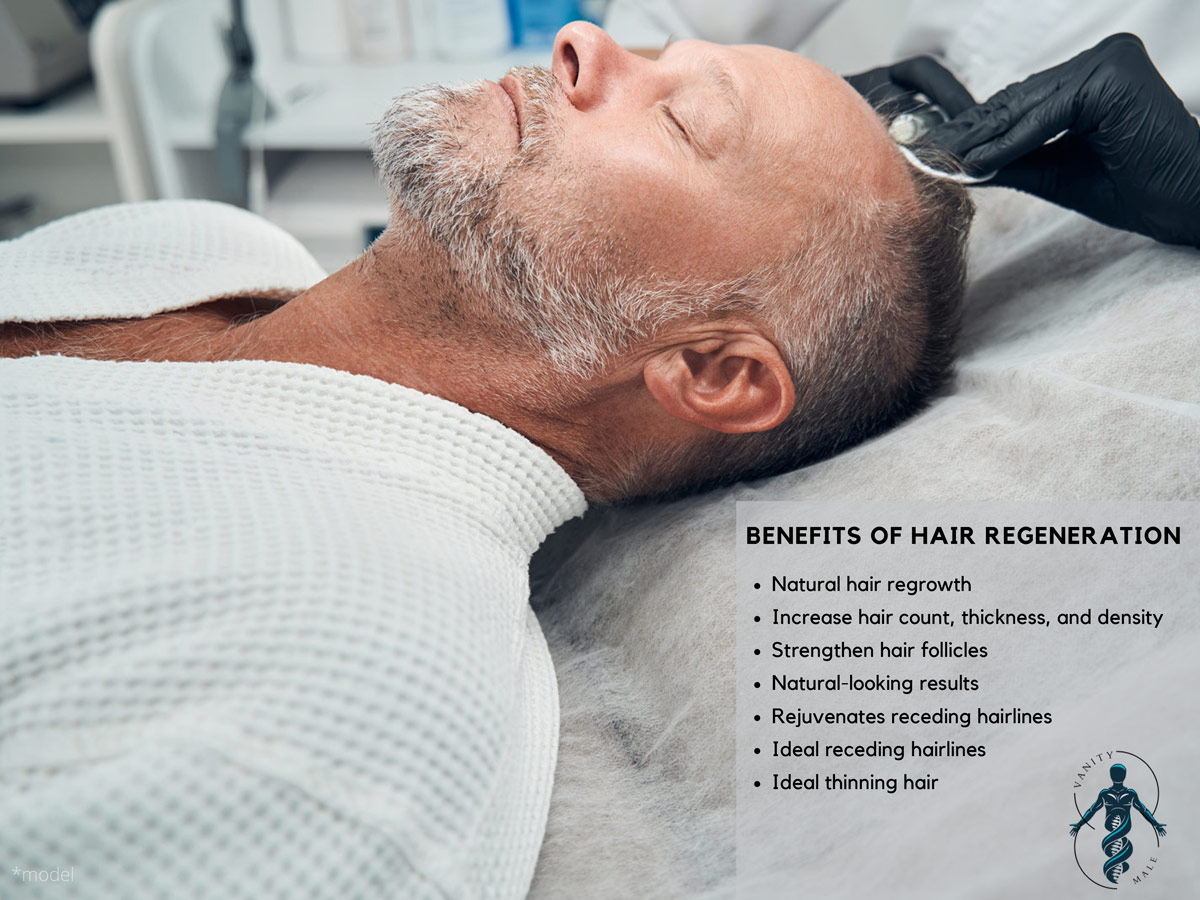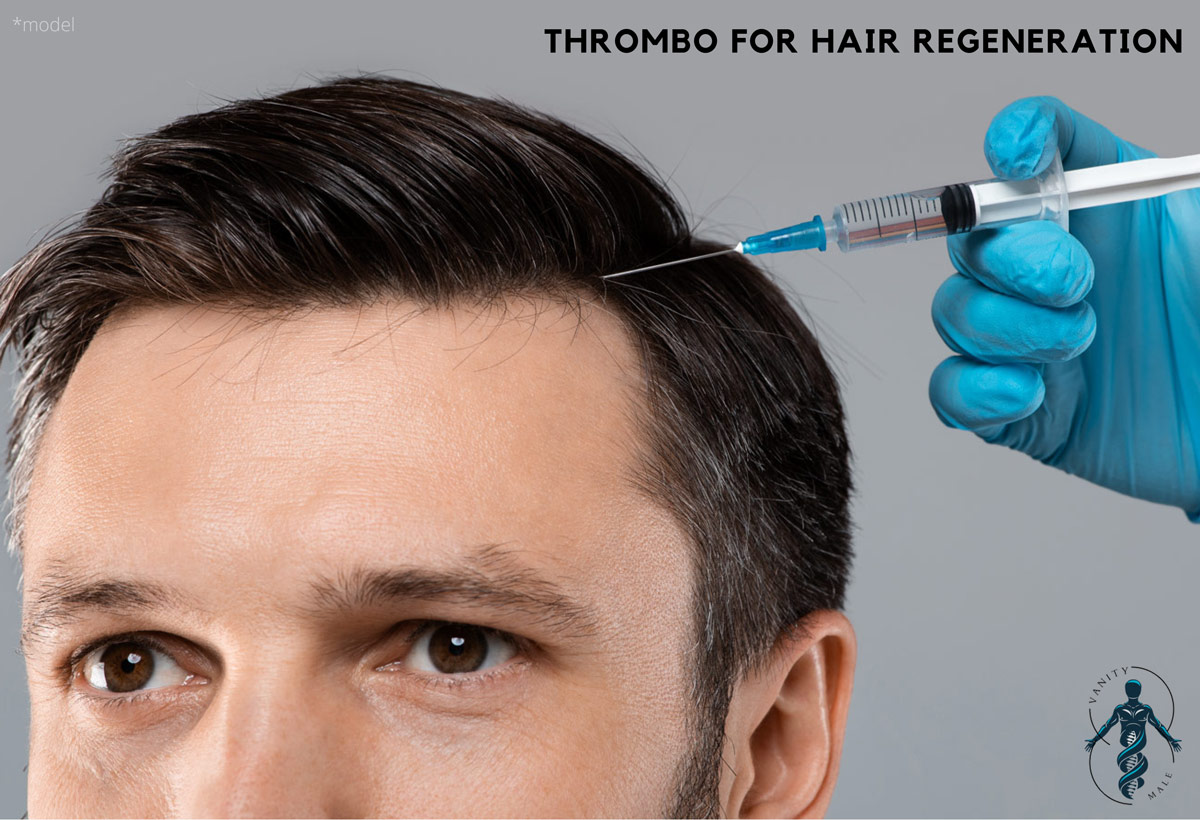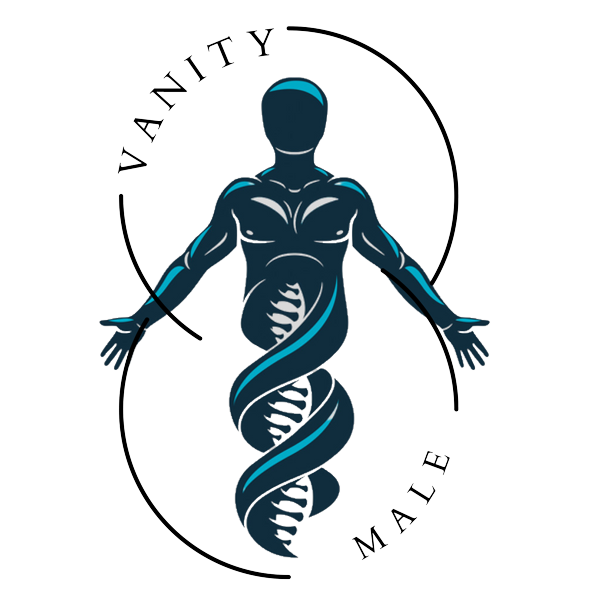We inject into the scalp to promote hair growth and prevent hair loss. Thrombo injections are effective in treating androgenic alopecia, which is also known as male pattern baldness.
What is Hair Regeneration?
Hair Regeneration is a non-surgical treatment for thinning hair and hair loss hair that makes use of adult stem cell-based wound-healing properties developed by hair restoration specialist, Dr. Berberian. Hair Regeneration treatments are customized in terms of concentrations, areas treated, depth of treatment and technique.

At Vanity Male we use the following methods:
Extracellular Matrix (ECM) — a wound healing material that attracts increased blood supply and adult stem cells, which duplicates human tissue like skin and muscle. When used in treating hair loss, ECM appears to clinically restore the necessary cells (progenitor cells) responsible for healthy hair growth.
Thrombo Injections: the isolated serum derived from a patient’s own blood which contains regenerative healing and growth factors. Thrombo is used in regenerative medicine applications in oral surgery, orthopedic surgery and cosmetic surgery.
Vitamin D — the nutrient, demonstrated by University of Tokyo, to increase transformation of cells in tissue culture to transplantable hair follicles.
Other materials customized to the patient’s cause of hair loss such as anti-inflammatory medication.

FAQs:
How Does Hair Regeneration Work?
The mechanism of how Hair Regeneration works has not been clearly defined as of yet. Platelet-rich plasma (PRP) and extracellular matrix (ECM) is injected into the scalp resulting in what appears to be a wound healing response from adult stem cells which results in the stimulation of hair growth and improvement in hair quality and longevity based on clinical observation.
Why do people experience hair loss?
Balding, also known as androgenetic alopecia, is a hereditary condition that develops in men and women. Pattern baldness is seen most commonly in men and it occurs because of an inherited genetic predisposition that causes hair to fall out with age. At least 50% of men will lose hair during their lifetime. Female pattern baldness also occurs because of genetic inheritance. It is more common than most people realize with one out of four women being affected at some point in their lifetime.
Are there any non-surgical hair replacement options?
There are two drugs approved by the FDA for the treatment of male pattern baldness – Rogaine and Propecia. Rogaine can be purchased over the counter at most local pharmacies. Propecia requires a written prescription from a physician. It is our experience that these drugs are more effective for maintaining existing hair than they are for regrowing previously lost hair. Although the drugs are marketed as treatments for hair loss, they usually provide little more than limited density restoration.
Does hair transplant surgery result in permanent growing hair?
Yes. Hair removed from the safe donor area regions in the back and on the sides of the scalp is genetically programmed to continue growing over the course of a lifetime without being affected by pattern baldness. Transplanted hair will continue to grow for life as long as the donor hair remains vigorous and viable.
Will hair transplant surgery restore my original hair density?
It is not possible to restore hair to its original density for most patients because of limitations relating to what can be borrowed from the donor region. Patients with excellent donor reserves may be able to achieve very dense hair using a dense-pack surgical technique. However, density and coverage possibilities vary from person to person and your restoration opportunities can only be determined with a face-to-face expert consultation.
Why are some transplants so obvious?
Outdated techniques, novice surgeons and assembly line-style clinics are generally responsible for unnatural or “pluggy” looking transplants. Clinics that view hair transplant surgery as big business rather than medicine tend to focus on quantity over quality. They may employ sub-par techniques and unethical behavior in order to profit from those affected by hair loss. It is your responsibility to do extensive research before choosing a surgeon.
How much pain is involved in a hair transplant procedure?
Premier hair restoration applies a gentle, local anesthetic before the surgery. This means that patients will feel no discomfort during the procedure. Patients may experience minor discomfort or tightness during the healing phase following surgery. Most patients remain comfortable during this time with little more than an over-the-counter analgesic like ibuprofen
Is it really possible to create a natural looking hairline?
Creating a completely natural hairline is the most important aspect of the surgery. We meticulously plan each hair transplant to provide the most natural hairline possible. Patients who qualify for hair replacement surgery can achieve remarkably natural results, as the satisfied patients in our gallery can attest.
Are there any risks associated with hair transplant surgery?
There are risks associated with every type of surgery which include infection, bleeding, and scarring. However, complications are extremely rare when the procedure is performed by a competent surgeon. There is also the chance that a patient may not achieve the fullness that he or she expected, which is why patients need to set realistic goals during their hair replacement consultation.
Dr.Berberian’s Hair Regeneration treatment is a quick and non-surgical approach to managing hair loss which has become established as a viable option in the management of hair loss in men and women.
Reclaim the confidence that accompanies a healthy, full head of hair. Discover if PRP hair regeneration is right for you by scheduling a consultation with Dr. Berberian
We are happy to offer CareCredit financing program for our patients!
